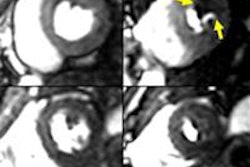As CT lung screening garners more attention, the question arises as to whether chest radiographs should be used at all for lung lesion detection. Radiation dose figures prominently in the debate due to CT's higher dose profile compared with radiography, according to poster presenter Dr. Lukas Ebner from Bern University Hospital.
To investigate the feasibility of microdose CT for lung nodule assessment, Ebner and colleagues used an anthropomorphic chest phantom with artificial lung nodules. Microdose CT parameters included 80 kV, 6 mAs, 0.6 pitch, and an increment of 1.1. Iterative reconstruction algorithms also were applied for maximum dose reduction.
Plain radiography in two projections was conducted in the prone position using the same phantoms. A total of 20 chest phantoms were scanned with lung nodules randomly placed in the lung parenchyma; five lung phantoms without lung nodules represented the control group.
Microdose CT was superior to chest radiography for detecting solid nodules between 5 mm and 12 mm in size at the same dose level of 0.05 mSv. The average gain in sensitivity with microdose CT was 43.7% ± 1.3%. The mean effective radiation dose for chest x-ray was 0.05 mSv; for microdose CT, the applied dose was 0.054 mSv.
"It is evident that CT is clearly the superior modality when it comes to early detection of suspicious lung lesions, especially smaller than 2 cm," Ebner said in an interview with AuntMinnie.com. "But in a clinical setting, there are often concerns about radiation dose of chest CT exams. With the recent technical advances, we believe that a chest CT with the dose of a regular chest radiograph can be acquired, finally solving the dose discussion."
In the near future, the researchers will implement their microdose CT protocol in a clinical screening routine, Ebner said.



















